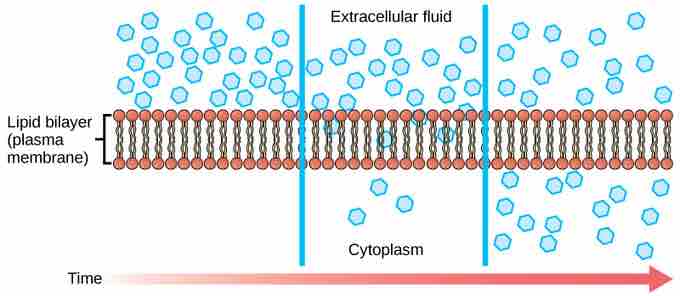Introduction: Passive Transport
Plasma membranes must allow or prevent certain substances from entering or leaving a cell. In other words, plasma membranes are selectively permeable; they allow some substances to pass through, but not others. If they were to lose this selectivity, the cell would no longer be able to sustain itself, and it would be destroyed. Some cells require larger amounts of specific substances than do other cells; they must have a way of obtaining these materials from extracellular fluids. This may happen passively, as certain materials move back and forth, or the cell may have special mechanisms that facilitate transport. Some materials are so important to a cell that it spends some of its energy (hydrolyzing adenosine triphosphate (ATP)) to obtain these materials. Red blood cells use some of their energy to do this. All cells spend the majority of their energy to maintain an imbalance of sodium and potassium ions between the interior and exterior of the cell.
The most direct forms of membrane transport are passive. Passive transport is a naturally-occurring phenomenon and does not require the cell to exert any of its energy to accomplish the movement. In passive transport, substances move from an area of higher concentration to an area of lower concentration . A physical space in which there is a range of concentrations of a single substance is said to have a concentration gradient.

Passive Transport
Diffusion is a type of passive transport. Diffusion through a permeable membrane moves a substance from an area of high concentration (extracellular fluid, in this case) down its concentration gradient (into the cytoplasm).
The passive forms of transport, diffusion and osmosis, move materials of small molecular weight across membranes. Substances diffuse from areas of high concentration to areas of lower concentration; this process continues until the substance is evenly distributed in a system. In solutions containing more than one substance, each type of molecule diffuses according to its own concentration gradient, independent of the diffusion of other substances. Many factors can affect the rate of diffusion, including, but not limited to, concentration gradient, size of the particles that are diffusing, and temperature of the system.
In living systems, diffusion of substances in and out of cells is mediated by the plasma membrane. Some materials diffuse readily through the membrane, but others are hindered; their passage is made possible by specialized proteins, such as channels and transporters. The chemistry of living things occurs in aqueous solutions; balancing the concentrations of those solutions is an ongoing problem. In living systems, diffusion of some substances would be slow or difficult without membrane proteins that facilitate transport.